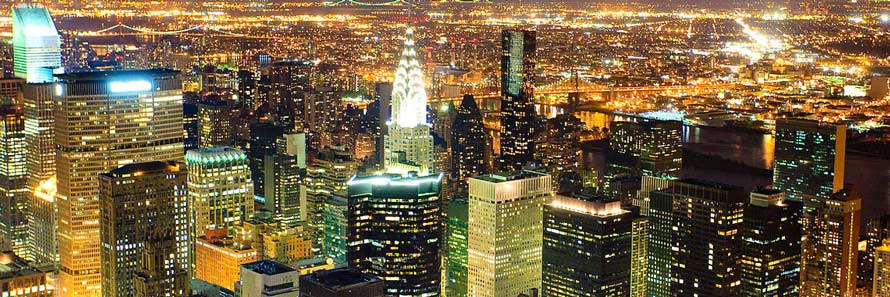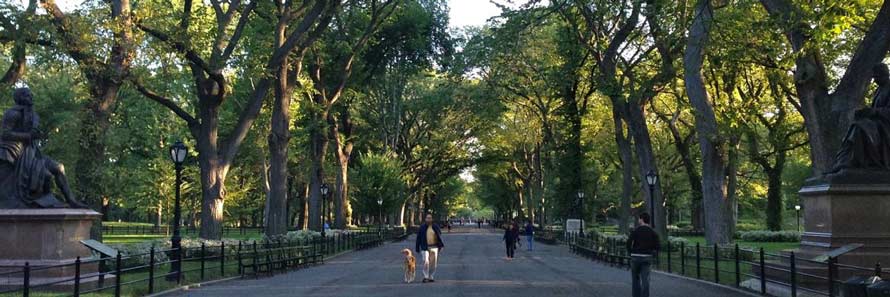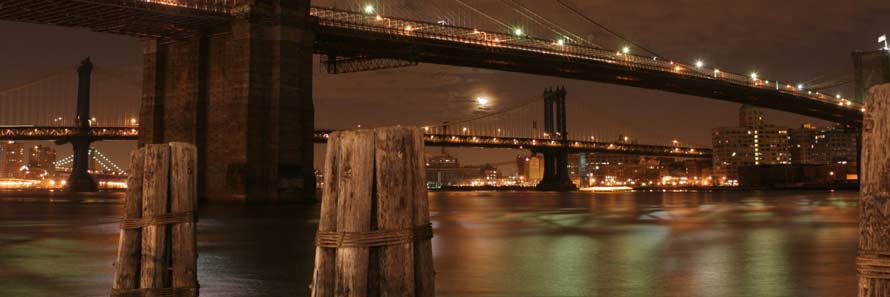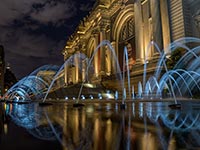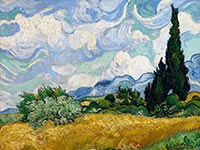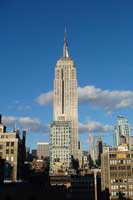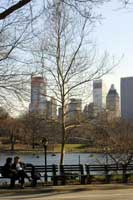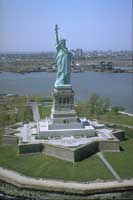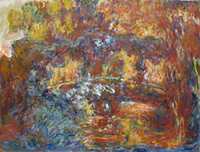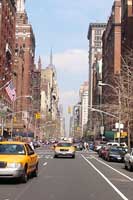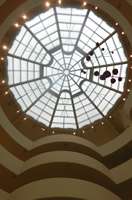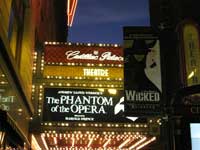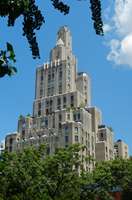Things to do in New York, USA
New York is home to 8.3 million people and is the world's financial and cultural capital.
It boasts the planet's most famous skyline (with 50 Skyscrapers of over 200 metres), iconic structures such as the Empire State Building, the Statue of Liberty and Brooklyn Bridge, many of the world's best museums (think the Metropolitan Museum of Art, MoMA, the Guggenheim), incomparable shopping (at the likes of Barney's, Bloomingdale's, Macy's, Saks ...), the Broadway stage, the Headquarters of the United Nations, scores of five star hotels, 42 Michelin-starred restaurants, top-rated sports teams, and its legendary buzz.
where? Manhattan, New York's central area, is a 21 x 4 kilometre peninsular surrounded by the Hudson and East Rivers. Most visitors arrive by plane to Newark, La Guardia and JFK Airports (c. 30-60 minutes from the centre of Manhattan by cab). Central Park (around which many of New York's museums are clustered) dominates Manhattan's upper side, underneath which is found the Theatre District and Times Square. Further south is the peaceful Greenwich Village, with the Lower Manhattan skyscraper district, Wall Street financial district and Brooklyn Bridge furthest south. Off the tip of the peninsular are found Liberty and Ellis Islands.
when? The Big Apple gets very hot in summer and bitterly cold in winter, making April-early June and September-November the best times to visit.
£$€¥ New York's many delights come with a hefty price tag! Expect to pay $250+ per night for a modest hotel room close to Times Square, $40+ per head for a sit-down mean, and at least $100 per ticket for a popular show. Public transport and taxis are fairly affordable. Some museums (such as the Metropolitan Museum of Art) do not levy an entrance fee. Don't forget that sales tax of up to 15% is added to many clothes and food purchases.
1. The Metropolitan Museum of Art
The Metropolitan Museum of Art can legitimately claim to be the most complete museum in the world.
It has a permanent collection of more than two million works, dating from prehistoric times to the present, and divided into 22 departments. Founded in 1870, and situated on the eastern edge of Central Park, the Museum attracts 5.2 million visitors a year.
Its departments include:
- 'American paintings and sculpture' (containing works by Homer, Bingham, Sargent and Whistler);
- 'Arms and armour' (housing a parade of soldiers on horseback and armour worn by Henry VIII);
- 'Asian art' (featuring a complete Ming Dynasty garden court);
- 'Egyptian art' (containing the Temple of Dendur, dismantled by the Egyptian government in 1965 and re-assembled at the Met in 1978);
- 'European Painting' (housing 37 Monets (including a number of Water Lilies), 21 Cézannes, 18 Rembrants, 13 Manet's (including the Spanish Singer, Boating and the Monets in their Garden) van Gogh's Self-Portrait with a Straw Hat and Duccio's Madonna and Child); and
- 'Greek and Roman art' (exhibiting a reconstructed bedroom from a villa entombed by the Vesuvius eruption).
Other departments include 'Modern art' (don't miss Jackson Pollock's Autumn Rythym), 'Islamic art' and 'Musical instruments' (including a Segovia guitar).
The Museum has a number of eateries, including the recommended Petrie Court Cafe on the ground floor.
As many days would be required to explore all the Museum has to offer, many choose to focus on one or two departments or take one of the self-guided tours recommended on the Museum's website.
where? 1000 Fifth Avenue at 82nd Street, New York. Information: 212-535-7710.
when? Six days a week (not Mon), 9.30 am to 5.30 pm (late night opening until 9 pm on Fri and Sat). Open on some 'holiday Mondays' (check website for details).
£$€¥ Though there is no admission fee, the recommended donations are as follows: Adults $25, Seniors (65+) $17, Students $12.
2. The Empire State Building
The 443-metre high Empire State Building was completed in 1931, after a period of construction of just 410 days.
It was officially opened by President Hoover, when he turned on its lights by pushing a button in Washington. The Building has a memorable arc deco design, 102 floors, 1860 steps, and is currently the tallest structure in New York. As might be expected, the Building offers the best vantage point in the city.
Visitors can buy tickets to the observation decks on the 86th and 102nd floors. But be warned: the ticket and elevator queues are almost as legendery as the building!
An alternative, less busy, vantage point is the Top of the Rocks attraction at the Rockefeller Centre. Famous for its art deco design, annual Christmas ice-rink and tree and as the home of NBC's studios, the Rockefeller's observation deck is on its 67-70th floors and offers panoramic views of the city from the heart of midtown Manhattan.
where? The Empire State Building is at 350 Fifth Avenue, between 33rd and 34th Streets, in midtown Manhattan. The Rockefeller Centre is found at 47th to 50th Streets.
when? The Empire State Building is open from 8 am to 2 am, seven days a week (last elevators at 1.15 am), 365 days a year. The Rockerfeller Centre is open 8am to midnight (last elevators 11pm).
£$€¥ For the Empire State Building's 86th floor observatory: $23 adults, $20 seniors (62 years+), $17 children (6-12 years), queue-busting pass $48 (all available online). An additional $17 ticket must be bought to access the 102nd floor observatory (available from the Building's 2nd and 86th floors only). The equivalent tickets for the Rockefeller Centre cost $25, $23 and $16.
3. Central Park
At 843 acres, Central Park is the largest metropolitan park in New York.
Situated in the heart of Manhattan, the Park is bordered on all sides by expensive real estate (and numerous skyscrapers). It attracts over 25 million visitors a year. The Park contains: lakes, ponds and a reservoir (with an encircling 3 kilometre running track); various walking tracks, bridle paths and woods; two ice-skating rinks (one of which is used as a swimming pool in high summer); a wildlife sanctuary and Zoo; and various sporting facilities. Highlights of Central Park's Zoo are sealions (who put on impressive performances at feeding time), snow leopards, red pandas, penguins and polar bears; a smaller adjacent Children's Zoo allows children to get close to goats, sheep, alpacas, cows and pot-bellied pigs. The Park hosts numerous cultural events every summer, including concerts by the New York Philharmonic and the Metropolitan Opera, and performances of plays by Shakespeare and others. A great place to unwind after a few days in the city.
where? The Park stretches from Central Park South (59th St.) to 110th St. at the northern end and from 5th Ave. on the east to Central Park West (8th Ave.) on the west.
when? 6 am to 1 am, 365 days a year
£$€¥ Free
4. The Statue of Liberty
The iconic Statue of Liberty, presented by the people of France in 1876 to mark the centenary of the Declaration of Independence, is located on the 12-acre Liberty Island.
Accessed by a short ferry ride, the Statue was designed by French sculptor Frederic-Auguste Bartholdi and is made from a steel skeleton engineered by Gustav Eiffel (who later designed Paris' eponymous tower). It is clad in copper, with gold-leaf covering the flame of its famous torch; the seven rays of the Statue's crown represent the seven seas and continents. It stands 93 metres tall and weighs 204 tonnes. Visitors can go to the top of the Statue's pedestal or climb the 365 steps to the Crown of the Statue (this climb is strenuous and only a very limited number of tickets are available). Also located in the Statue's pedestal is a museum exhibit about the Statue.
where? Liberty Island, New York Harbour (accessible by ferry only). Ferries are operated by Statue Cruises and leave from the Battery Park ferry terminal. Tickets are sold at the Castle Clinton National Monument (next to Battery Park). Subways: #1 train to South Ferry, #4 or #5 to Bowling Green, R or W train to Whitehall Street. Buses: M1, M6, or M15 to Battery Park.
when? Generally 8.30 am to 6.15 pm, but opening hours are adjusted seasonally. Closed 25 Dec.
£$€¥ Access to the Island is free. Ferry charges: Adults (13+) $12, Seniors (62+) $10, Children (4-12) $5. $3 surcharge for tickets to the Crown (reservations must be made well in advance at http://www.statuecruises.com/).
5. The American Museum of National History
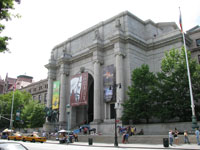
Founded in 1869, the American Museum of National History has a collection of over 150 million specimens, many of which are dsplayed in its 46 permanent exhibition halls.
Its most impressive exhibits include: the Hall of Human Origins (which traces the story of evolution, displaying the important 3.2 million year old 'Lucy' skeleton); the Gem and Mineral Halls (which exhibits the 632 carat Patricia Emerald, the 563 carat sapphire known as the Star of India, and the largest cut stone in the world); the Hall of Meteorites (which holds a 34 tonne section of the Cape York meteorite); and the numerous fossil halls (which display a Tyrannosaurus rex composed of real bones from two skeletons, and a giant Brontosaurus skeleton). Annexed to the Museum is the architecurally stunning Rose Center for Earth and Space, which houses the Museum's planitarium.
where? Central Park West at 79th Street, New York. Tel (212) 769 5100. Subway: B (weekdays only) or C to 81st Street. Train: the 1 train stops at Broadway and West 79th Street. Buses: M7, M10, M11, M79, M86 and M104.
when? 10 am to 5.45 pm, seven days a week. Closed 25 Dec and Thanksgiving Day.
£$€¥ Adults $16, Seniors/Students with ID $12, Children (2-12) $9.
6. The Museum of Modern Art (MoMA)
Founded in 1929, MoMA now holds 150,000 paintings, sculptures, drawings, prints, photographs, architectural models and drawings, and design objects.
Dedicated to modern art from the 19th Century onwards, the museum displays its collection in a 59,000 square metre granite and glass building designed by Japanese architect Yoshio Taniguchi and opened in late 2004. MoMA's treasures include: Cézanne's The Bather; Dalí's The Persistence of Memory; Matisse's The Dance; Monet's Polar's at Giverny and waterlillies; various Picasso nudes; Pollock's Number 31, 1950; Rousseau's The Sleeping Gypsy; van Gogh's The Starry Night; and Warhol's Campbell's Soup Cans. Regarded by many as the world's pre-eminent modern art museum, MoMA also has two café's and a Michelin-starred fine-dining restaurant.
where? 11 West 53 Street, between Fifth and Sixth avenues. T: (212) 708-9400. E: info@moma.org. Directions from the east side of Manhattan: 6 train to 51st Street, transfer to the E or V train; one stop to 53rd Street and Fifth Avenue; buses: M1, 2, 3, 4, or 5 to 53rd Street. From the west side of Manhattan: E or V train to 53rd Street and Fifth Avenue, or B, D, or F train to 47-50 Street Rockefeller Center; buses: M50 cross-town to 50th Street.
when? 10.30 am to 5.30 pm, six days a week (not Tues). Late opening Fri till 8.00 pm. Closed: Thanksgiving Day and 25 Dec.
£$€¥ Adults $25, Seniors (65+) $18, Students (with ID) $14, Children (under 16) free. Entry is free on Fridays between 4 pm and 8 pm.
7. The Bronx Zoo
The Bronx Zoo houses over 4000 animals and, at 265 acres, is the largest zoo in the US.
It has five main attractions ('African Plains', 'Congo Gorilla Forest', 'JungleWorld', 'Madagascar!' and 'Tiger Mountain’), together with smaller indoor and outdoor exhibits. The Congo Gorilla Forest, a 6.5 acre area housing 20 western lowland gorillas, is highly recommended. Another must-see is the recently opened Madagascar! zone, which attempts to recreate a small section of the island and holds lemurs, geckos, cockroaches (which hiss at 90 decibels!), tree boas, and Nile crocodiles. Other inhabitants of the zoo include aardvarks, grizzly and polar bears, African wild dogs, geladas, giraffes, gazelles, tree kangaroos, African lions, several varieties of monkey (including the tiny Pygmy Marmoset), silver pheasants, Siberian tigers, and zebras.
where? Address: 2300 Southern Blvd, Bronx, NY 10460. Phone: (718) 220-5100. Express bus: the BxM11 stops along Madison Avenue, between 26th and 99th Streets, then travels directly to the zoo. Other buses: from Bronx, take Bx9 or Bx19 buses to 183rd Street and Southern Blvd, or the Bx12 or Bx22 buses to Fordham Road and Southern Blvd (then walk 5 blocks south on Southern Blvd to 183rd Street); from Queens, take the Q44 to 180th Street and Boston Road. Subway: #2 or #5 train to East Tremont Ave/West Farms Square. Train: Metro North’s Harlem line to Fordham, then take the Bx9 bus eastward to 183rd Street and Southern Blvd.
when? Summer: Mon – Fri: 10 am to 5 pm; weekends and holidays: 10 am to 5.30 pm. Winter: 10 am to 4.30 pm. Closed: Thanksgiving Day, Christmas Day, New Year's Day and Martin Luther King Day.
£$€¥ Adults $15, Seniors (65+) $13, Children (3-12) $11.
8. Shopping on Fifth and Madison Avenues
Fifth Avenue, to the east of Central Park, runs from Greenwich to the heart of Midtown.
Its central section, regularly rated as one of the most expensive pieces of real estate in the world, is famous for its high-end shops and museums. The shopping (generally between 34th and 60th Street) includes Tiffany, Cartier, Gucci, Louis Vuitton, Prada, Armani, Versace, van Cleff & Arples and de Beers. The museums (found between streets 80 to 100, aka 'museum mile') include the Met and the Guggenheim Museum (not to mention the Empire State Building, the NY Public Library, the Rockefeller Centre and St Patrick's Cathedral). Next door, Madison Avenue boasts a similarly impressive list of flagship stores, including Hermès, Chanel, Asprey, YSL, Dolce & Gabbana, Vera Wang, Dior, Graff and Ralph Lauren.
where? Subway: Fifth Avenue-53rd Street station. Buses: M1, M2, M3, and M4 NYCT Buses, and the BxM1, BxM2, BxM3, BxM4, and BxM5 express buses.
when? Normal business hours.
£$€¥ Free to look, expensive to buy!
9. The Staten Island Ferry
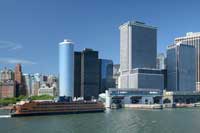
Staten Island is one of New York's five boroughs. The best way to get there from Manhattan is by taking the Staten Island Ferry.
The Ferry, which now only transports pedestrians and cyclists, takes about 22 minutes to reach its destination. But the views are fantastic. As you pull out of the Manhattan ferry terminal, you will be able to see Ellis Island and the Statue of Liberty on your right, and the Governor's Island and Long Island on your left. The New York skyline (to the back of the boat) will come into view after a few minutes, as will the bridges of lower Manhattan. As if that were not enough, the whole experience won't cost you a dime: the ferry, operated by the New York City Department of Transportation, has been free since 1997. www.siferry.com
where? Whitehall Terminal Manhattan (also known as South Ferry) 4 South Street, New York. Buses: M1, M9, M6, M15. Subway: R, W (to Whitehall Street) 1, 9 (to South Ferry), 4,5 (to Bowling Green), and J,M,Z (to Broad Street).
when? Ferries sail round-the-clock, at least every 30 minutes. Ferries run every 15 or 20 minutes during busy periods.
£$€¥ Free
10. The Guggenheim Museum
Opened in 1959, the Solomon R Guggenheim Museum, known simply as the Guggenheim, displays impressionist, post-impressionist, early modern, and contemporary art.
Housed in a distinctive Frank Lloyd Wright designed building, sometimes described as a white ribbon curled into a cylindrical stack, the museum holds many world-class pieces. They include: Paul Cézanne Man with Crossed Arms, Willem de Kooning, Composition , Vasily Kandinsky Group in Crinolines, Ernst Ludwig Kirchner Artillerymen, Pablo Picasso Woman Ironing, Jackson Pollock Ocean Greyness, Henri Rousseau The Football Players, Georges Seurat Farm Women at Work, and Vincent van Gogh Mountains at Saint-Rémy.
where? Solomon R. Guggenheim Museum, 1071 5th Avenue (at 89th Street). Tel: 212 423 3500. E: visitorinfo@guggenheim.org. Subway: 4, 5, or 6 train to 86th Street. Buses: M1, M2, M3, or M4.
when? Open six days a week (not Thurs) 10 am to 5.45 pm. Late opening Saturday, till 7.45 pm. Closed 25 Dec and Thanksgiving Day.
£$€¥ Adults $18, Students and Seniors (65+) $15, Children under 12 free.
11. Broadway
New York has about 40 theatres with a capacity exceeding 500 seats, which collectively grossed close to $1.36 billion over the 2014-15 season.
Along with London's west-end, Broadway represents the highest level of commercial theatre in the English speaking world. Shows playing at the moment include: The Book of Mormon, One Man Two Guvnors, Memphis, War Horse, Wicked, The Phantom of the Opera (which, at the Majestic Theatre, is on a run exceeding 9000 shows), Mamma Mia, Chicago, Jersey Boys, West Side Story and Mary Poppins. So why not get dressed up, pop out for a quick pre-theatre meal, and then sit back and enjoy the magic of the stage.
where? Various theatres located on or around Broadway.
when? Matinees usually start at 2 or 3 pm (normally Wed, Sat and Sun), and evening performances at 7 or 8 pm (normally Tues to Sat).
£$€¥ Tickets for top shows range between $50 and $300 depending upon the show, performance and seat. Two ways of purchasing tickets are recommended. First, from the tkts bureau in Times Square (which offers discount tickets on the day of performance). Secondly, from the theatres themselves (with many offering tickets for 'sold out' shows on the day of performance for those prepared to queue).
12. Greenwich village
Escape the hubbub of downtown by taking a visit to Greenwich Village, a largely residential area on the west side of Lower Manhattan.
Located close to Washington Square Park and New York University, and with a haphazard street layout, the Village was originally the Bohemian capital of the US (and the birthplace of the beat movement). Now home to upper middle class families, the Village is known for its good non-chain restaurants, coffee shops and bars; its street entertainers, musicians, and chess players; the attractive Jefferson Market Courthouse; the 4th Street Basketball Court (where you can see some of the best street players); several pretty parks and squares; and, above all, the vibe. The Village was the setting for the sitcom Friends. A recommended smaller attraction is the Merchant's House Museum, a Greek revival townhouse maintained as a monument to the wealthy merchant family who occupied it for most of the 19th century.
where? The Village has Broadway to its east, the Hudson to its west, Houston Street to its south, and 14th Street to its north. Transit: A, C, E, B, D, F and V (to West 4th Street), R and W (to 8th St-Broadway).
when? All year round, but especially during the afternoons and evenings.
£$€¥ Free.
